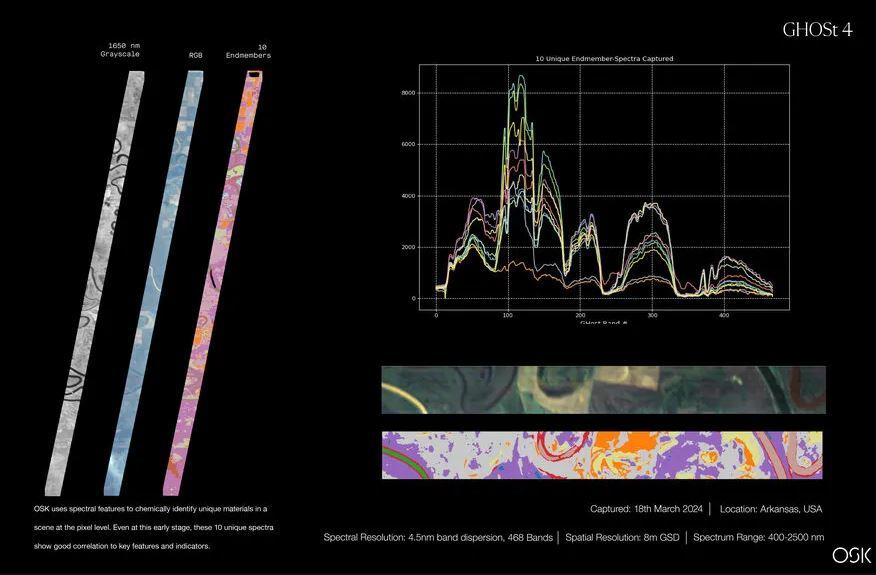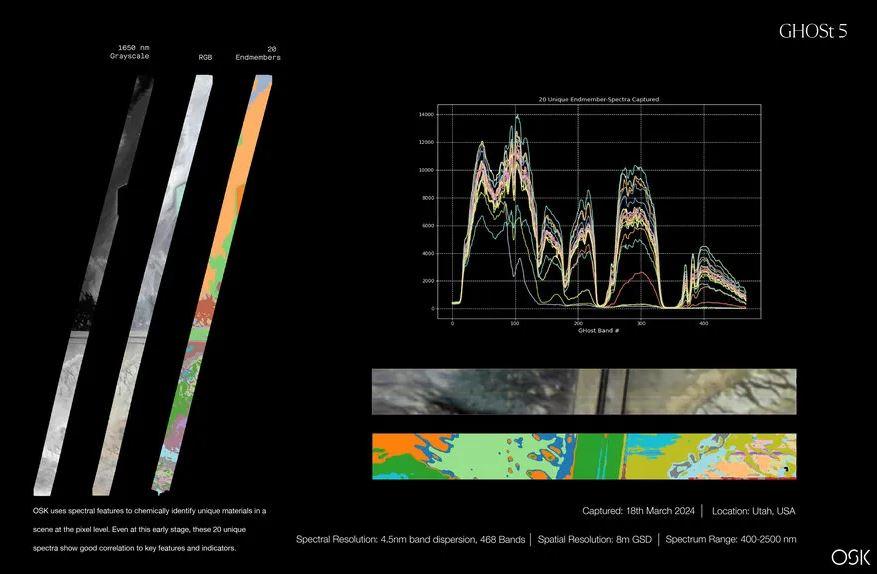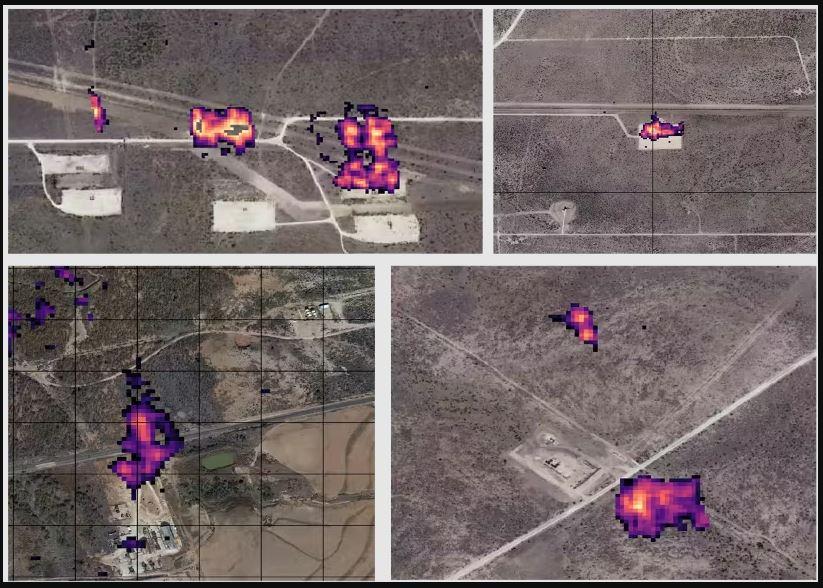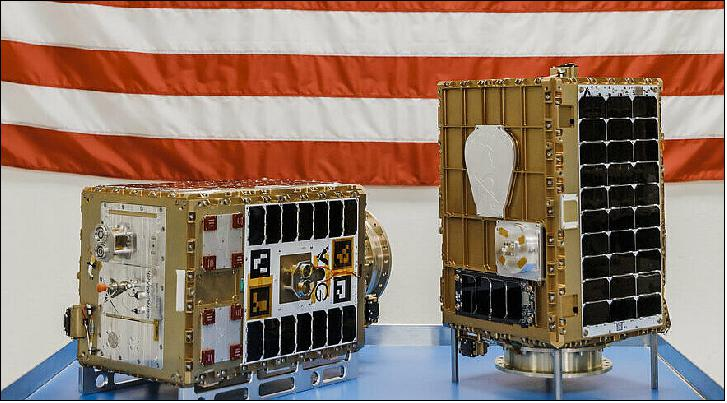GHOSt (Global Hyperspectral Observation Satellite)
EO
Atmosphere
Operational (nominal)
Atmospheric chemistry
With the first satellites launched on 15 April 2023, Global Hyperspectral Observation Satellite (GHOSt) is a constellation of six technically identical hyperspectral imaging microsatellites by Orbital Sidekick Inc. (OSK). GHOSt aims to build on its predecessor Aurora to provide enhanced commercial data sets used in industrial, government, agriculture, environmental and defence sectors.
Quick facts
Overview
| Mission type | EO |
| Agency | Orbital Sidekick |
| Mission status | Operational (nominal) |
| Launch date | 15 Apr 2023 |
| Measurement domain | Atmosphere |
| Measurement category | Trace gases (excluding ozone) |
| Measurement detailed | CH4 Mole Fraction, N2O (column/profile), CO2 Mole Fraction |
| Instruments | HI |
| Instrument type | Atmospheric chemistry |
| CEOS EO Handbook | See GHOSt (Global Hyperspectral Observation Satellite) summary |

Summary
Mission Capabilities
Each GHOSt satellite features a proprietary hyperspectral imager manufactured by OSK. The sensor is developed to capture 512 spectral bands across the visible (VIS) to shortwave infrared (SWIR) region.
The enhanced monitoring provided by these imagers will enable GHOSt to produce the highest resolution commercial hyperspectral imagery launched to-date. Some key applications include capturing critical environmental and situational awareness information for defence, detecting minute real-time changes in physical infrastructure, monitoring energy infrastructure and regulatory compliance, detecting environmental erosion and degradation, and monitoring crop yield and agriculture.
Performance Specifications
With a revisit rate of up to daily for certain locations the hyperspectral sensors onboard the constellation will provide a spatial resolution of 8.3 m for multispectral band and 3 m for panchromatic bands.
GHOSt satellites are anticipated to operate at an average altitude of 525 km in a circular sun-synchronous orbit with an inclination of 97.5°.
Space and Hardware Components
Developed by Astro Digital, each of the GHOSt satellites have a mass of 91.4 kg and a planned total in-orbit lifetime of just over 5 years. The spacecraft are based on the flight-proven Corvus-XL smallsat platform and utilise Astro Digital’s heritage flight computer, attitude determination and control subsystem (AOCS), power and communications subsystems.
Payload data downlink is to be conducted via Ka-band, in addition to S-band for high speed data (HSD) transmissions.
GHOSt (Global Hyperspectral Observation Satellite)
Overview
Orbital Sidekick (OSK) Inc., a startup company of San Francisco, announced on 4 February 2021 that it has finalised plans to deploy its Global Hyperspectral Observation Satellite constellation known as GHOSt. The hyperspectral imaging (HSI) constellation consists of six 100 kg ESPA [EELV (Evolved Expendable Launch Vehicle) Secondary Payload Adapter] class microsatellites, designed and manufactured by Astro Digital, with Maverick Space Systems providing mission integration & management services for the launches on SpaceX’s Falcon 9. The custom hyperspectral imaging payload is provided by OSK. 1)
OSK provides innovative remote sensing solutions for a diverse set of industrial and governmental customers, including end users across the energy, surveying and extraction, agriculture, environmental monitoring, and defence sectors. Examples of the kinds of data sets OSK provides its customers include protein content and evapotranspiration levels for crops, corrosion identification and leak detection for monitoring pipelines, accurate mineral surveying, environmental monitoring for various applications, and real-time road/rail infrastructure conditions. The GHOSt constellation represents the next evolution of OSK’s sensing capabilities and will allow OSK to scale its commercial product with larger coverage, reduced revisit times, better spatial resolution, and more spectral capability.
GHOSt leverages OSK's previous experience collecting and analysing hyperspectral data with its ISS-HEIST (Hyperspectral Earth Imaging System Trial) mission on the International Space Station in 2019. The custom payload will produce the highest resolution commercial hyperspectral imagery launched to-date with a GSD (Ground Sample Distance) of approximately 8 metres. The payload will be integrated into Astro Digital's Corvus-XL satellite platform and will take advantage of its industry leading Ka-band data downlink capability.
"We're excited to partner with Astro Digital and Maverick Space for this initial constellation. Both companies bring a high degree of agility with proven execution to our mission, allowing OSK to focus on the payload and extracting information from our unique hyperspectral data," said Pete Friedhoff, Director of Space Systems for Orbital Sidekick.
"Persistent, hyperspectral imaging is a critical new capability in remote sensing," said Chris Biddy, Co-founder and CEO of Astro Digital. "We are very pleased to be supporting Orbital Sidekick's mission with our proven satellite technology and capabilities."
Maverick Space Systems will provide mission integration hardware and services to launch GHOSt on SpaceX's Falcon 9 at the end of this year and continuing into 2022. "Taking advantage of frequent low-cost launch opportunities is critical to achieve Orbital Sidekick's constellation. We are excited to partner with them and further reduce their per-satellite launch costs by aggregating two GHOSt satellites per ESPA port," said Roland Coelho, CEO of Maverick Space.
GHOSt will capture more than 400 spectral bands in the visible to shortwave infrared range of 400 - 2500 nm to feed OSK's Spectral Intelligence Global Monitoring Application (SIGMA™) platform.
GHOSt will enable enhanced hyperspectral monitoring capabilities for commercial, scientific, and government applications. Upon deployment, the GHOSt constellation satellites will produce the highest resolution commercial hyperspectral imagery launched to-date. The market-leading sensing capabilities provided by OSK enable customers in the energy, extraction, infrastructure, agriculture, and forestry industries to make vital decisions with better information, thereby improving safety and potentially saving lives.
The following are just some of the key industry sectors that will benefit from capabilities unlocked by the GHOSt constellation:
- National Defence: GHOSt’s hyperspectral sensors can capture critical environmental and situational awareness information for use in national defence and crisis response efforts, including plume, camouflage, chemical weapon signatures, and target detection. In October 2020, the United States Department of the Air Force’s commercial investment group, in conjunction with the Space and Missile Systems Center, and the Air Force Research Laboratory, contracted with OSK to accelerate the deployment of these services.
- Infrastructure Monitoring: GHOSt’s hyperspectral imaging can detect minute changes in physical infrastructure and report such changes in real-time, allowing operators to monitor the integrity of their mission-critical infrastructure more closely and maintain infrastructure more cost effectively. GHOSt is particularly well suited for monitoring energy infrastructure, such as oil and gas pipelines, and for ensuring regulatory compliance, such as leak prevention and early leak detection.
- Environmental and Agricultural Monitoring: GHOSt will enable customers to collect and access vital data on environmental erosion and degradation, including the evapotranspiration levels for crops. These data sets provide OSK customers with early-warning detection of water, air, and land pollution, as well crop viability and yield. Taken together, the GHOSt constellation will provide valuable new services for customers in the United States and around the world.
Spacecraft
The GHOSt mission will involve deploying a remote sensing constellation of small satellites with both radiofrequency and optical payloads. The satellite constellation will consist of six technically identical satellites launched into a sun-synchronous orbital inclination in Low Earth Orbit (LEO). Each satellite is planned to have a total in-orbit lifetime of 5.2 years.
The spacecraft bus is based on Astro Digital’s flight-proven Corvus-XL smallsat platform and utilises Astro Digital’s heritage flight computer, attitude determination and control system, power, and communications subsystems. The payload for each satellite consists of a proprietary hyperspectral imager manufactured by OSK. Each satellite has external dimensions of 57.8 cm x 57.8 cm x 111.4 cm and a total mass of 91.4 kg. Each satellite is equipped with state-of-the-art hardware and software solutions to ensure safe and efficient mission operations. Each GHOSt satellite will be capable of making orbital adjustments and performing collision avoidance manoeuvres by utilising differential drag, but will not carry propulsive systems.
RF Communications
The GHOSt system plans to operate in the radiofrequency bands outlined in Table 1 below. Satellite downlink transmissions can be turned on and off by ground telecommand. Although the GHOSt satellites are capable of transmitting throughout the entire orbit, they only transmit when visible to one of their Earth stations.
Table 1: Transmission Specifications
Type of Link and Transmission Direction | Frequency Ranges |
EESS Downlink | 25.5 – 27.0 GHz |
EESS and TT&C Uplink | 2025 – 2110 MHz |
Inter-Satellite Service (Transmit) | 1615 – 1617.5 MHz |
Space Operations Service Downlink (TT&C) | 400.15 – 401 MHz |
GPS Signals | L1 C/A, L1C, L2C, L2P, L5 |
A. Ka-Band Payload Downlink
OSK seeks to utilise the 25.5-27.0 GHz Ka-Band for payload downlink operations under the co-primary EESS (space-to-Earth) allocation. All data transmitted in the requested band will be limited to payload sensor data or metadata directly pertaining to the operation of the payload.
The high gain Ka-band antennas employed by the GHOSt satellites will use six band channels, allowing for six wideband emissions to share three frequency channels using polarisation diversity, thereby enabling the GHOSt satellites to utilise the spectrum at its highest efficiency.
B. S-Band Adaptive Coding and Modulation and TT&C Uplink
In addition OSK is looking to utilise the 2025-2110 MHz S-band for Telemetry, Tracking, and Command (TT&C), as well as modulation and coding of the high speed data (HSD) link for payload transmissions. Specifically, OSK plans to use the 2045.0-2050.0 MHz band for the HSD control uplink. This technique adjusts the satellite’s modulation and coding to optimise payload downlink conditions, ensure proper link performance and efficiency, and advise the spacecraft to retransmit any lost data frames. A second link, operating within the 2054.85-2055.15 MHz band, will provide the traditional TT&C uplink operations for the GHOSt satellites.
C. UHF TT&C Downlink
The GHOSt constellation will use the 400.15-401.0 MHz band for TT&C downlink telemetry operations consistent with the secondary allocation for the Space Operation service
D. L-Band Intersatellite Links
OSK plans to use a space-to-space L-band intersatellite link between its GHOSt satellites and the existing commercial Globalstar NGSO constellation. The GHOSt satellites will transmit to Globalstar satellites, pursuant to an agreement with Globalstar, but will not have the capability to receive communications from the Globalstar satellites.
Launch
GHOSt-1 and GHOSt-2, the first two satellites of Orbital Sidekick’s planned GHOSt constellation, were successfully launched on 15 April 2023 at 06:48 am UTC onboard the Transporter 7 rideshare mission on a SpaceX Falcon 9 rocket, from Vandenberg Space Force Base in California.
GHOSt-3 was launched on 12 June 2023 at 2:35 PDT (21:35 UTC) on SpaceX’s Transporter 8 rideshare mission, from Space Launch Complex 4E at Vandenberg Space Force Base (VSFB) in California. The Falcon 9 rocket carried 72 payloads of varying sizes. 7)
GHOSt-4 and 5 were launched on 4 March 2024 at 6:54 PM EST, on SpaceX’s Falcon 9 rocket, from Cape Canaveral Space Force Station, Florida. 13)
Orbit
GHOSt-1 has 498.6 km perigee, 514.7 km apogee, 97.4 ° inclination, a period of 94.6 minutes and a semi-major axis of 6877 km
GHOSt-2 has 497.1 km perigee, 514.5 km apogee, 97.4 ° inclination, a period of 94.6 minutes and a semi-major axis of 6876 km
Given that the first two satellites were launched together from the same launch vehicle, the initial phase angles are very small. Over time, the two satellites in the given plane will separate further within their respective orbital planes and eventually be separated by 180°.
GHOSt-3 has an altitude of 525 km and is in a sun-synchronous orbit. 8)
GHOSt-4 has an altitude of 525 km and is in a sun-synchronous orbit. 11)
GHOSt-5 has an altitude of 525 km and is in a sun-synchronous orbit. 12)
Table 2: Anticipated orbit specifications
Orbital Plane Number | 1 | 2 | 3 |
Number of Satellites within the Orbital Plane | 2 | 2 | 2 |
Inclination Angle | 97.5° | ||
Orbital Period | 5708 seconds | ||
Apogee | 525 km | ||
Perigee | 525 km | ||
Argument of Perigee | 0° | ||
Active Service Arc | -90° to 90° | ||
Right Ascension of the Ascending Node | 30° | 330° | 0° |
Initial Phase Angles | <10° between each satellite | ||
Local Time of Descending Node | 1330 | 1000 | 1000 |
Mission Status
• April 3, 2024: Orbital Sidekick (OSK) released first-light imagery from the two hyperspectral satellites launched on March 4, 2024 (Figures 1 and 2). Both satellites, part of OSK's constellation which now includes five satellites, are in good health and undergoing commissioning. These satellites collect data across 468 spectral bands from 400 to 2,500 nanometers with 8-meter resolution. A sixth satellite is expected to launch within the year, and OSK aims to expand to a constellation of 14 to 20 satellites for weekly global monitoring. The hyperspectral data allows for detailed chemical analysis, particularly useful in detecting methane and hydrocarbon leaks, and monitoring potential threats to pipelines. This enables proactive measures to prevent leaks and ensure pipeline safety. 15)


• March 4, 2024: GHOSt-4 and 5 were launched at 6:54 PM EST, on SpaceX’s Falcon 9 rocket, from Cape Canaveral Space Force Station, Florida. 13) 14)
• August 23, 2023: Orbital Sidekick (OSK) has revealed early insights from its GHOSt™ constellation, comprising GHOSt 1, 2, and 3, launched via the Transporter 7 and 8 missions. These satellites, featuring advanced hyperspectral sensors with an 8-meter ground sampling distance, provide the highest resolution hyperspectral monitoring available. This capability allows OSK to monitor Earth, focusing initially on oil and gas pipeline infrastructure, and detect methane plumes with high precision. OSK has developed sophisticated tools to analyze hyperspectral imagery, enabling the identification of specific risks to energy infrastructure, such as pipeline threats from suspicious vehicles or construction activities. In 2023, OSK's hyperspectral sensors scanned 12,000 miles of pipeline, identifying 100 methane leaks, 200 hydrocarbon leaks, and over 300 construction-related threats, while building a proprietary spectral library to enhance their chemical analysis capabilities. 10)


• June 12, 2023: Orbital Sidekick (OSK) announced the successful launch of GHOSt 3, the third satellite in its planned GHOSt (Global Hyperspectral Observation Satellite) constellation aboard the Transporter 8 rideshare mission. 9)
• April 15, 2023: Orbital Sidekick have announced the successful launch of GHOSt 1 and 2, the first satellites in its planned GHOSt™ (Global Hyperspectral Observation Satellite) constellation, aboard the Transporter 7 rideshare mission on a SpaceX Falcon 9 rocket. 6)
• October 3, 2022: Orbital Sidekick (OSK) has signed a technical assistance agreement with the U.S. Geological Survey’s (USGS) Earth Resources Observation and Science (EROS) Center as part of the Joint Agency Commercial Imaging Evaluation (JACIE) partnership. This agreement enables remote sensing experts from various government agencies, including USGS, NASA, NGA, NOAA, USDA, and NRO, to assess the quality and scientific utility of OSK's satellite imagery. Ensuring reliable product quality is crucial for supporting diverse remote sensing applications across government, NGOs, industry, and academia. Collaborating with USGS also allows OSK to expand its market reach in the ESG sector, enhancing objective and consistent environmental monitoring services. 5)
• June 23, 2022: Orbital Sidekick (OSK) has been selected by Energy Transfer, a North American energy infrastructure company, to monitor its assets in the Permian Basin using OSK’s advanced hyperspectral satellite technology. This partnership enhances Energy Transfer's pipeline integrity programs, surpassing regulatory requirements to ensure the safety and efficiency of its extensive pipeline network. OSK's technology allows for early detection and prevention of leaks, improving community safety, environmental performance, and operational efficiency. With the deployment of OSK’s GHOSt constellation starting in late 2022, OSK will provide frequent monitoring services to the global oil and gas industry via its SIGMA Platform, aiding in compliance, regulatory obligations, and promoting sustainable operations. 2)
• February 24, 2022: Orbital Sidekick (OSK) is facing capacity constraints as it acquires data from Aurora, its first satellite launched in June 2021. Aurora, a precursor to the upcoming GHOSt constellation, launched via SpaceX’s Transporter-2 mission, has outperformed NASA’s Hyperion sensor. The GHOSt constellation, set to launch later this year, will offer significantly improved resolution of 8 meters per pixel. OSK is ramping up production and hiring to meet high demand for its dual-use satellite technology, with substantial backing from In-Q-Tel and AFVentures. This support aligns with the intelligence community's hybrid approach to Earth observation, utilizing both government and commercial satellite data. 3)

• October 15, 2020: Orbital Sidekick (OSK) has secured a $16 million multi-year contract from the Department of the Air Force's AFVentures, alongside the Space and Missile Systems Center (SMC) and the Air Force Research Laboratory (AFRL), under the Strategic Financing (STRATFI) program. This funding, matched by private investment, will expedite the launch of six advanced hyperspectral imaging satellites with edge processing capabilities and integrate OSK’s SIGMA™ platform with the USAF's Advanced Battle Management System (ABMS). The SIGMA™ platform offers persistent global monitoring services, utilizing OSK’s high-fidelity hyperspectral data across more than 400 spectral bands. The first satellites are set to launch in December 2021, aiming for a daily revisit rate. This advancement supports both defense and commercial sectors, enhancing analytical insights for remote sensing challenges. 4)
Sensor Complement
GHOSt will capture more than 400 spectral bands in the visible to shortwave infrared range of 400 – 2500 nm to feed OSK’s Spectral Intelligence Global Monitoring Application (SIGMA TM) platform.
Ground Segment
The Mission Operations Center for GHOSt will be located at OSK’s headquarters in San Francisco, California and at Astro Digital’s facility in Santa Clara, California. Consistent with OSK’s National Oceanic and Atmospheric Administration (NOAA) licence, the GHOSt constellation will be monitored at all times via automated and human systems, facilitating rapid response to any technical or regulatory concerns. OSK will conduct its mission operations through a network of ground stations that will initially consist of facilities in (i) Santa Clara, California; (ii) Tromso, Norway, (iii) Svalbard, Norway, and (iv) Troll, Antarctica. OSK may expand its ground station network over the course of the operational lifetime of the GHOSt constellation to include additional commercial stations either within or outside the United States and will seek to modify its authorization as conditions arise. OSK has initiated coordination efforts with Federal operators in its requested bands and will operate in accordance with the terms of any agreements.
References
1) ”Orbital Sidekick Announces Upcoming Launch of its Newest Global Hyperspectral Earth Observation Constellation: GHOSt,” PR Newswire, 4 February 2021, URL: https://www.prnewswire.com/news-releases/orbital-sidekick-announces-upcoming-launch-of-its-newest-global-hyperspectral-earth-observation-constellation-ghost-301222258.html
2) ”Orbital Sidekick to Monitor Pipeline Assets for Energy Transfer Using Satellite Technology,” OSK, 23 June 2022, URL: https://www.orbitalsidekick.com/news-blog/orbital-sidekick-to-monitor-pipeline-assets-for-energy-transfer-using-satellite-technology
3) Debra Werner, ”Orbital Sidekick notes growing demand for hyperspectral data,” SpaceNews, 24 February 2022, URL: https://spacenews.com/orbital-sidekick-aurora-in-q-tel/
4) ”Orbital Sidekick Awarded $16M U.S. Air Force STRATFI Contract,” Orbital Sidekick, 15 October 2020, URL: https://orbitalsidekick.com/news-blog/
5) “Orbital Sidekick secures UGSG Technical Assistance Agreement”, News Desk, 3 October 2022, URL: https://www.geospatialworld.net/news/orbital-sidekick-secures-usgs-technical-assistance-agreement/
6) GeoSpatial World, "Orbital Sidekick Successfully Launches First Satellites in GHOSt Constellation", April 18, 2023, URL: https://www.geospatialworld.net/news/orbital-sidekick-successfully-launches-first-satellites-in-ghost-constellation-2/
7) Lentz Danny, "SpaceX Transporter-8 launches 72 payloads marking 200th booster landing", NSF (Nasa Space Flight), June 12, 2023, URL: https://www.nasaspaceflight.com/2023/06/spacex-transporter-8/
8) Gunter’s Space Page, “GHOSt 1, 2, 3, 4, 5, 6”, URL: https://space.skyrocket.de/doc_sdat/ghost-1.htm
9) Geospatial World, “Orbital Sidekick Successfully Launches Third GHOSt Satellite”, June 14, 2023, URL: https://www.geospatialworld.net/news/orbital-sidekick-third-ghost-satellite/
10) Orbital Sidekick (OSK), “OSK Debuts Initial Hyperspectral Insights from GHOSt Constellation”, Aug 23, 2023, URL: https://www.orbitalsidekick.com/news-blog/osk-debuts-initial-hyperspectral-insights-from-ghost?utm_source=substack&utm_medium=email
11) OSCAR, “Satellite: GHOSt-4”, URL: https://space.oscar.wmo.int/satellites/view/ghost_4
12) OSCAR, “Satellite: GHOSt-5”, URL: https://space.oscar.wmo.int/satellites/view/ghost_5
13) De la Cruz, Lia, “List of SpaceX Starlink launches for March 2024”, EarthSky. March 1, 2024, URL: https://earthsky.org/spaceflight/spacex-starlink-launches-march-2024/
14) Gunter’s Space page, “GHOSt 1, 2, 3, 4, 5, 6”, URL: https://space.skyrocket.de/doc_sdat/ghost-1.htm
15) SpaceNews, “Orbital Sidekick shares first-light imagery”, April 3, 2024, URL: https://spacenews.com/orbital-sidekick-shares-first-light-imagery/